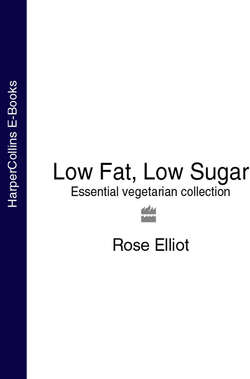Читать книгу Low Fat, Low Sugar: Essential vegetarian collection - Rose Elliot - Страница 7
Оглавлениеlow-fat, low-sugar ingredients
After all my comments about foods which are not used in this book you’re probably wondering what on earth you can eat. Actually it’s surprising how many ingredients are suitable:
Fresh vegetables: all kinds can be eaten – raw or cooked, in soups, salads, main courses and, in the case of some of the sweeter ones such as butternut squash, as the basis for desserts and cakes. Choose organic if possible to avoid the risk of chemical residues. If you can’t manage to go completely organic, do choose organic carrots, lettuces and soya (also bananas, strawberries, milk and chocolate if you’re eating these). I’d also like to add organic potatoes to that list and hope that it won’t be very long before organic produce is the norm rather than the exception in all our food shops.
Frozen and canned vegetables: some of these are useful but make sure that they do not contain added sugar. Look for organic tomatoes canned without citric acid, particularly if you’re on the diet to combat candida. Canned sweetcorn without added sugar or salt is useful; also frozen sweetcorn, peas and broad beans.
Lemons: the only fruit permitted, apart from a little lime rind and juice which I’ve used very occasionally. Lemon juice is used instead of vinegar in dressings and a squeeze at the end of cooking is a useful flavour-enhancer in many dishes. Buy unwaxed, preferably organic lemons, especially if you’re going to use the skins as well as the juice.
Pulses: dried beans and lentils are wonderful, virtually fat-free sources of protein, fibre, minerals and vitamins. Many recipes in this book include these in either their dried or canned form. Again, buy organic if you can. Canned organic pulses are now available from large supermarkets and health food stores and are very handy, though dried pulses are easy to prepare.
To prepare pulses, cover with cold water and soak for 8 hours, or bring to the boil and leave to soak for 1 hour. Rinse and cover generously with fresh cold water. Boil rapidly for 10 minutes before reducing the heat and letting them boil gently until tender: usually 1–11/2 hours. Lentils and split peas cook in 20–60 minutes, depending on the type – they don’t need soaking before cooking although if you do soak them they cook more quickly. All pulses freeze well. For convenience, cook a 500g/18oz bag, divide into 5 portions and freeze – each portion will be the equivalent of a 425g/15oz can of beans.
Whole grains: this group includes brown rice, quinoa, millet and flaked brown rice, as well as brown rice flour and polenta (maize flour). Couscous is a refined, not a whole grain; bulgur wheat is a more nutritious alternative and is just as easy to prepare. Wholewheat pasta is also very useful in the diet. If you can’t eat wheat, non-wheat pastas made from vegetables, corn, millet and rice are available from health food stores.
Tofu: this useful and nutritious ingredient is used in quite a few of the recipes. It’s particularly important to buy an organic type to ensure that it hasn’t been made from GM soya beans.
Low-fat plain organic yogurt: If you can’t tolerate any dairy produce, use an unsweetened soya yogurt instead. You can buy this from health food stores, or it’s easy to make your own (see page).
Soya milk: unsweetened organic soya milk is used in recipes instead of dairy milk.
Organic free-range eggs: egg whites are used in a few of the recipes in this book.
Cold-pressed organic olive oil: this is used only in a handful of the recipes. If you wish to add a light misting of oil to vegetables before roasting or frying, you might like to make an oil spray by putting some olive oil into a spray bottle, topping up with 8 parts of cold water and shaking and spraying when required.
Spices: apart from the very hot spices, such as chilli and cayenne, these are usually allowed and are invaluable for making low-fat, low-sugar meals taste really good. A particular favourite in this book is cumin, in both seed and powdered form; ground coriander and turmeric are also invaluable, as is nutmeg – buy it whole and grate as required. Freshly ground black pepper can also be used freely. Buy the spices as you need them for a particular recipe and you’ll soon build up a useful collection.
Fresh herbs: I think the availability of a wide range of fresh herbs is one of the factors that has made the most impact on our cooking in the last ten years. They are a wonderful way of adding freshness and flavour to dishes and make a very appetising garnish. Fresh ginger and garlic are also indispensable flavourings.
Salt: may not be recommended by most health experts, but it is difficult to reduce while still retaining flavour. As a substitute, I have recently been using a sodium-reduced sea salt from Iceland. It is the best of the reduced sodium salts that I have tried. Reduced sodium salts contain a higher percentage of potassium than normal salt, so if you’re having treatment for a kidney or heart disorder, check with your doctor before using it.
